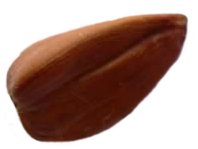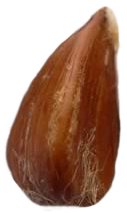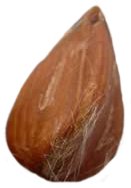

Beech Nuts

Fagus. (The Greek and Latin word for the tree.) BEECH. Fagaceae. Ten species of monoecious, deciduous trees, to 40m or more. Crown rounded, spreading; bark smooth, grey. Shoots slender, brown, persistent at first; buds 1-3 x 0.2-0.4cm, narrowly ellipsoid. Leaves alternate, 2-ranked, entire to dentate, shiny. Male flowers bourne in long slender, pedunculate heads, perianth 4-7-lobed, stamens 8-16; female flowers 2-3 together, perianth 4-6-lobed, ovary 3-chambered; peduncle short, stout, to 2.5cm, or longer, more slender, to 7.5cm. Fruit solitary, pedunculate; casing a 1.5-3cm involucre or cupule, covered with soft, often spathulate spines, mature in 6-7 months, splitting open in four sections to release the two (occasionally three) enclosed or partially exserted nuts; nuts 1.5-2cm, ovoid-acute, triangular in section, glossy chestnut-brown with a small basal pale scar. N Temperate. CultivationOnly Fagus sylvatica is widely cultivated away from its native range; this is due to its exceptional climatic tolerance, evolved in the rapid climatic changes in Europe during the ice ages. It is happy both in continental E US (to zone 4 with hot summers) and oceanic Scotland (zones 8-9 but with cold summers), requiring only a good rainfall, 700mm (or 1100mm where summers are hot) to 1800mm. In S Europe it is confined to mountains, where rainfall is high; the same applies to California and SE Australia. It is oblivious to pH, content both on pure chalk and acid sand, but does need a well-drained yet moist soil. Although best in valley shelter, it tolerates mountain exposure well, but not salt; it performs poorly in coastal exposure and is often killed by road de-icing salt. It has also been affected by metal toxicity caused by acid rain on sensitive soils in some areas, though little affected by normal urban air pollution. Almost all beech cultivars belong to this species; it is also an excellent hedge plant, and will retain its withered foliage if juvenility is stimulated by pruning. The other species all demand warm summers to a greater or lesser extent but are otherwise very similar; Fagus orientalis is the next most tolerant, while the American and Chinese species grow only slowly in the cool summers of Britain while doing well in the E US. Of these, Fagus lucida and Fagus japonica are the most attractive, with dainty glossy green and glaucous blue-green leaves respectively; Fagus engleriana is also good. All species have good autumn colour. Propagation is as for Quercus (Oaks), except that the seeds are a little more tolerant of drying, and the seedlings do not produce a taproot, so normal nursery procedures can be used. Plant when 2-4 years old and 30-60cm tall. Seed should be from extensive single-species stands or wild-collected if their identity is to be guaranteed. Cultivars are grafted on seedlings of Fagus sylvatica. Young trees are very shade tolerant and shelter for the first few years is beneficial; in open ground they can be frost damaged. 
The most important disease is beech bark disease, caused by coral-spot fungus Nectria coccinea, which colonises the punctures left by a bark-feeding woolly aphid, the felted beech coccus Cryptococcus fagi; the fungus kills patches of bark and sometimes the whole tree by girdling. It is frequent only on dry sites and only kills or injures trees which are under stress, usually through drought. Outbreaks are most serious in S England after hot, dry summers, and are rare in N England and Scotland where humidity is higher. It is also seen on hedge plants, where pruned shoot ends allow the fungus to colonise, causing dieback rather than bark damage. The bracket fungus Ganoderma applantatum causes decay and root rot in old, usually senescent trees (150-350 or more years old); if large brackets are produced, the tree is soon likely to be blown down. It may occur in younger trees if the root system is damaged. Other decay fungi causing similar problems include Stereum species and Armillaria mellea; the entry of these is often through the wounds made by beech bark disease. The foliage is attacked by several insects, but none is grave; the nuts can be infested by weevils (Curculonidae), and are also eaten by woodpigeons, jays, squirrels and other wildlife. Fagus crenataJAPANESE BEECH. Tree to 40m. Leaves 7-13 x 5-6.5cm, elliptic-ovate to rhombic, when widest below middle, apex short-acuminate, margins shallow crenate, with veins ending in sinuses, 7-10-veined, veins soft pubescent when young. Fruit glossy mid-green, paler beneath, peduncle 1-2cm, short pubescent; cupule scaly bristled, basal scales bracteate, spathulate to linear; nuts 2, as for Fagus sylvatica. Japan. Z4. Fagus englerianaCHINESE BEECH. Tree occasionally to 20m, branching from base. Shoots slender; bud 20-25 x 2mm. Leaves 13 x 4-6cm, lanceolate to elliptic-ovate, entire and undulate to remotely dentate, veins bourne in 10-14 pairs, pubescent, apex short-acuminate, yellow-green above, blue-green beneath. Fruit on slender, glabrous peduncles to 6cm; cupule 15mm, bracteate, linear foliose at base; nuts 2, fully enclosed. C China. Z6. Fagus grandifoliaAMERICAN BEECH. To 35m. Shoots slender, glabrous; bark pale grey; buds brown, shiny. Leaves 6-15 x 4-7cm, obovate to oblong, blue green above, paler beneath, coarsely serrate, veins in 10-15 pairs, ending at teeth; petiole to 10mm. Fruit on peduncle to 2.5cm, short-pubescent; cupule short-pubescent, scales curved or straight; 2 occasionally 3 nuts, included in cupule. Eastern N America. variety caroliniana. Leaves shorter, ovate, less obviously dentate. Cupule with shorter scales. Z4. Fagus japonica
JAPANESE BLUE BEECH. To 25m. Leaves 5-13 x 4-6cm, elliptic-ovate to ovate, apex acute, base cuneate, margin slightly crenate to subentire, glabrous, blue-green above, glaucous beneath, midrib somewhat downy, veins in 9-15 pairs, ending in sinuses; petiole to 10mm. Fruit on a 2.5-3cm peduncle; cupule short, to 8mm; 2 nuts, exserted about half their length from cupule. Japan. Z5. Fagus longopetiolataTo 25m. Leaves 6-14 x 4-7cm, ovate to oblong-ovate, margin dentate, apex acuminate, base cuneate, bright green above, downy and glaucous beneath, veins in 9-12 pairs; petiole 1.5-3cm, glabrous. Fruit on 4-5cm peduncle; cupule to 2.5cm, short-pubescent, scales slender, reflexed; nuts 2, fully enclosed. C and W China. Fagus lucidaTree to 15m. Leaves 5-10 x 2.5-5cm, narrow-ovate, veins in 8-10 pairs, exserted in sinus of leaf margin as 1mm teeth, otherwise shallow-crenate; petiole to 13mm. Fruit on slender peduncle to 7cm, slender, glabrous; cupule scales somewhat triangular, apices recurved; nuts 2, exserted. W China. Z6. Fagus X moesiaca(Fagus sylvatica X Fagus orientalis). Trees with longer, narrower leaves than Fagus sylvatica and 6-11 pairs of veins, but fruit as Fagus sylvatica, are probably natural hybrids. Balkan Peninsula. At least one named clone of copper beech (see Fagus sylvatica) has leaves to 6-13cm with 8-10 pairs of veins, and is probably a Fagus species. Z5. Fagus orientalis
Tree to 40m. Leaves 8-17 x 5-8cm, usually elliptic oblong to obovate, margins distinctly dentate, veins in 7-13 pairs with apices at teeth; petiole to 15mm. Fruit on 2-3cm peduncle; cupule to 2cm, basal scales spathulate; nuts 2, as Fagus sylvatica. SE Europe, SW Asia, N Iran, Caucasus. Z5. Fagus sylvaticaCOMMON BEECH; EUROPEAN BEECH. Tree to 48m; bark smooth, grey. Leaves 5.5-11 x 3.5-6.5cm, elliptic-ovate, margins undulate-crenate, often remotely denticulate, ciliate, veins in 5-9 pairs, soft-pubescent. Fruit on peduncle to 2.5cm; cupule to 2.5cm or more, scales narrow, subulate, spreading to erect nuts 2, 1.8mm, fully enclosed. C Europe to Caucasus. forma tortuosa. Branches curiously twisted. Scatterd colonies occur in a line from S Sweden to NE France; origin unexplained. Over 30 named cultivars and dozens more unnamed; most come more or less true from seed. forma purpurea. (COPPER BEECH) covers the many purple-leaved clones, forma pendula (WEEPING BEECH) the pendulous clones, and forma laciniata (CUT-LEAF BEECH; FERN-LEAF BEECH) the clones with deeply cut leaves. ‘Dawyck’ (DAWYCK BEECH) is fastigiate and ‘Zlatia’ (GOLDEN BEECH) has golden leaves in spring. Most traits are now available in combination; ‘Rohan Obelisk’ is a purple cut-leaf, fastigiate tree. Z5.
|
Home
Grow Herbs
Grow Fruit
Grow Vegetables
Cyberian Index
If you like this website and want one of your own contact
Cyberian All information correct at
time of publication and open to updates as necessary. No part of this website,
or its vectors, may be produced in any shape or form, using any type or design
of medium, system, equipment or otherwise without the prior written consensual
notice of the Cyberian. Any breach of these requirements will result in the
appropriate action. If in doubt, e-mail contact is recommended.
Some components of this website were obtained as open-source software and are
used in the same non-profit manner on this website.